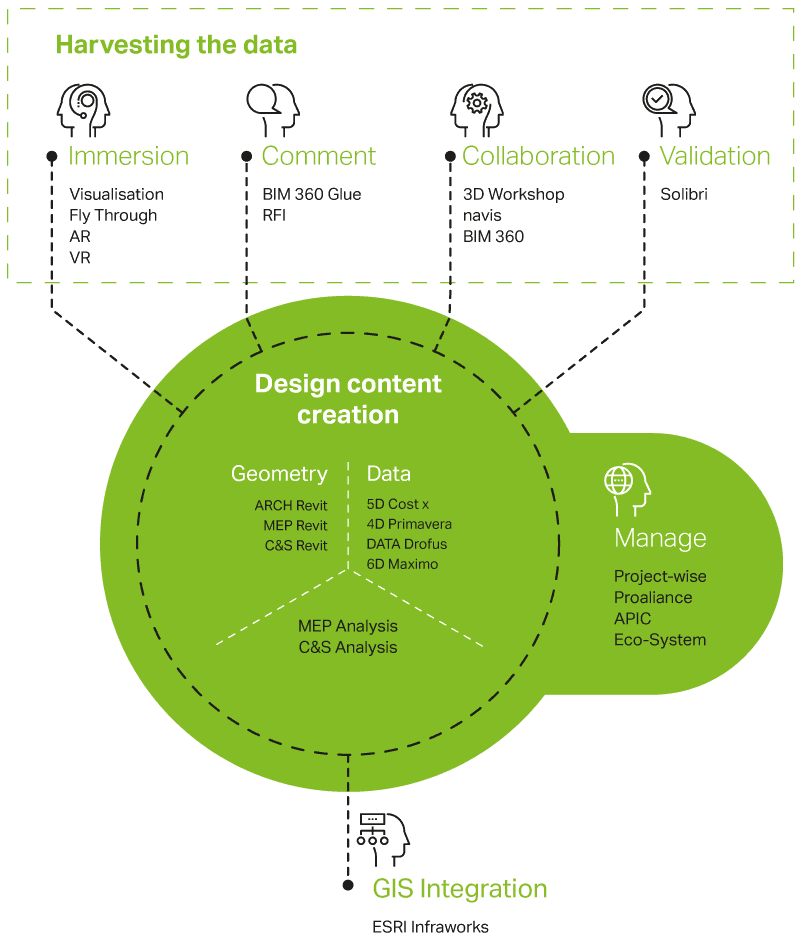BIM as a risk management tool
Architects have been harnessing the geometric aspects of BIM for many years resulting in a new generation of more complex building forms; but with ever increasing datasets, delivery cost is also being driven down as a consequence of BIM.
Contractors are harnessing 4D (time) technologies linking their construction programmes to the design team’s BIM model, thus enabling varying construction strategies to be rehearsed, hence reducing site risk and optimising delivery.
Cost risk is also being managed by allowing commercial teams to more effectively link into the design model using 5D techniques that link into predefined templates that feed into historical cost databases.

Although these initiatives are driving innovation today, the next generation of BIM tools will focus on new ways of harnessing the geometry and data of the design models themselves, with risk management tools being the catalyst to a fully integrated delivery model.
- Autodesk and Trimble have recently entered into an operability agreement that underlines the importance software providers are putting on more effective ways of connecting design and project management. The development of new bespoke project ecosystems which connect geometry and data together, allowing “real-time” interactions and analytics between design team members is becoming more common, for example:
- Using ‘design to cost’ dashboards that provide architects with real-time cost data to allow the impact of design decisions to be instantly assessed and refined.
- Allowing the early examination of innovative construction approaches such as ‘flying factories’ and modular construction to help radically decrease assembly and construction time, whilst improving health and safety, cost and sustainability outcomes.
- Harnessing 3D tools as part of new coordination and design management processes, hence speeding up the iterative design process
Immersive technologies are radically changing the way we design, presenting better ways of communicating the developing designs to clients, shifting design team meetings and presentations away from the two dimensions of the meeting table. Meetings can be hosted inside design models with participants, and their avatars, joining in from around the world to discuss design issues in profoundly different ways, transitioning away from 2D information towards contemporary 3D connected environments.

Connecting project information in real-time significantly reduces project risks by minimising the time lag between issues, and the receipt and use of information. With an ever increasing number of parties using project information, real-time collaboration reduces the risk of any party using out of date information. Crucially, risks are managed by making sure the right information is available at the right time, and by connecting this information more effectively more rapid iterations of the design process are possible. For example, allowing a cost plan to be automatically updated upon receipt of the latest design team release, or enabling an engineer to rapidly assess the implications of a change in architectural specification.
Strategic project risks will continue to be managed in project workshops that identify key issues and determine who is best placed to own, manage, reduce and eliminate each risk as a project progresses. However, ultimately the aim is to fully enable project management teams to provide real-time feedback to the design team regarding the status of these risks, so as to speed up the process of resolution.
Looking to the future, likely key trends will be;
- The further automation of the design process using coding and scripting tools such as Grasshopper and Dynamo, which are currently used to define parametric geometry.
- The development of new quality assurance processes built around 3D workflow and coordination processes, offering the ability to automatically validate design models by checking against predetermined rulesets.
- The use of machine learning and other artificial intelligence techniques to improve decision-making.
BIM is taking construction on a journey from current analogue structures towards new digital working methodologies. Innovation that is not only driving efficiencies in delivery and out-turn cost, but also improving health and safety and risk management.






